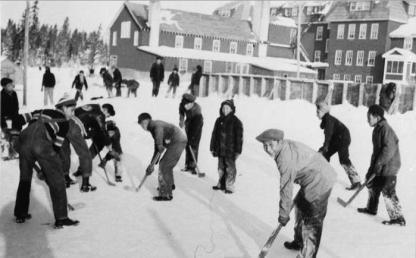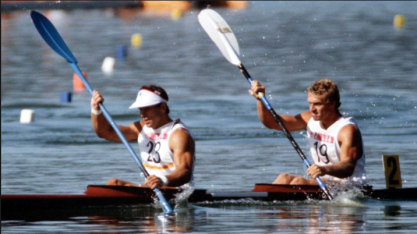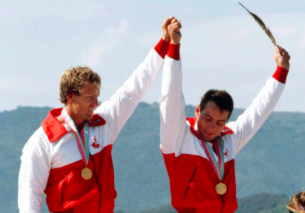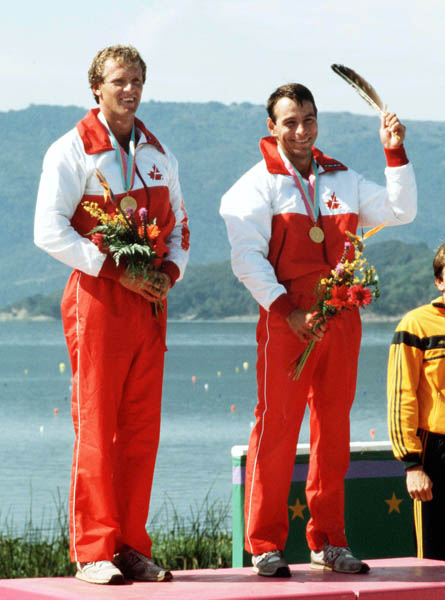Who is Alwyn Morris?
Alwyn Morris, born in 1957, grew up on the Mohawk Nation of Kahnawake, Quebec located near Montreal. It is here that he started kayaking as a teen and began excelling athletically. In the coming years, Morris and his Caucasian partner, Hugh Fisher, would win World Championships in kayak-doubles before making a name for themselves at the Los Angles 1984 Olympics. Morris & Fisher won bronze in the men’s K-2 2500m, before winning gold in the K-2 1000m. Like many athletes, the two were celebrated by Canada for their gold medal win, while Morris was commemorated for more.
At this moment, Alwyn Morris became the first Aboriginal Canadian Summer Olympic athlete to win gold and remains to be the only one able to do so. With the whole world watching, Morris stood on the podium and proudly raised an eagle feather; which represents life, honour, and friendship in Native American culture. It allowed the Aboriginal Canadian athlete to self-identify and share his victory with Indigenous Canadians, while also paying tribute to his supportive grandparents who raised him and signifying respect to his grandfather who had passed In this moment, the young aboriginal athlete did not have to say anything for the World, Canada, and Aboriginal communities to hear him.
Alwyn Morris with Hugh Fisher on the Olympic Podium. Photo from Library and Archives Canada.
The History of Kayaking in Canada
Historically, kayaking has been utilized by North American Indigenous peoples in transportation, hunting, and sporting contexts. For instance, it is well documented that the Inuit peoples have historically encouraged athletic development for kayaking through traditional practices, such as balancing games for children (Walls, 2012). This sport was first used by Indigenous communities for enjoyment purposes and to support their tribe.

Aboriginal youth in a kayak. Photo from Canada’s First Peoples.
As Europeans began to make Canada their home, Indigenous sports like kayaking and lacrosse were adopted and rivalries between Caucasian and Native American people manifested (King, 2006). This sports rivalry arguably contributes to the social construction of Indigenous race and Canada’s racial hierarchy still present today. These ideas surrounding native bodies, ultimately lead to the implementation of policy and law that dispositioned Indigenous communities in opportunities of sport.
The legislation imposed by the government created conservations to be white, upper-class spaces that did not allow racialized individuals within its’ confines. In making these white spaces possible, Indians were dispositioned and displaced for the benefit of the white society. For example, Native American traditional hunting practices were illegal in conservations, while their white counterparts “nobly” hunted as a leisurely biblical activity. These outdoor spaces have become a part of Canada’s nationalism, with outdoor sport contributing to its’ narrative; as depicted in Discover Canada: The Rights and Responsibilities of Citizenship.The historical implications surrounding Indigenous peoples, outdoor spaces, and the appropriation of their traditional sports limit the space available for Indigenous presence at the elite kayaking and sport.
The Only Aboriginal Canadian
Not many would deny that Morris’ hard work and determination got him to the podium, but few would realize what has preserved his title as the only Aboriginal Canadian Summer Olympic athlete to win gold. The Canadian systems that created sociopolitical barriers for Indigenous Canadians have been reinforced over time. These barriers continue to deny Indigenous peoples the opportunity to succeed, and historical implications of outdoor spaces and Indigenous groups narrows the chance of having the right set of circumstances to succeed.
The Indian Act of Canada was established with the intention of “civilizing the Indians,” which included placing them on reserves in remote locations and segregated from Western society (Bartlett, 1978). This sociopolitical and physical separation was caused by white separatism that was evident at the time; which refers to the separation of whites and “others” as accomplished by creating separate states. It has left Indigenous peoples dispositioned with limited accessibility to power, privilege, and access in a variety of ways including sporting opportunities.

Aboriginal youth participating in hockey. Photo from Active History.
This Act was also used to create residential schools, that utilized sport as a tool for assimilation into Western culture. Acceptable sports, such as hockey, baseball, and basketball, were used to teach Native children to self-govern themselves and distinguish between behaviours deemed ‘civilized’ or ‘savage’ (Forysth, 2006). Additionally, Potlatch Law implicated traditional Indigenous physical activities and incrimination, which worked in conjunction with residential schools to assimilate Indigenous peoples into Western culture (Loo, 1992). Through Canadian politics, the scope of acceptable and accessible sports for Native Americans narrowed. This is observed in the history of kayaking, as the opportunity for Indigenous participation has continuously been dispositioned and their opportunities to excel have been limited.
Why Morris’ Story is Shared

Morris and Fisher during the 1984 Olympics. Photo from Olympic Club.
Citizens of Canada celebrated the shared moment of Morris raising the eagle feather as it reflected our nation’s diverse cultural presence and athletic excellence on the world stage. But this recognition and celebration are not always afforded to racialized individuals. For example, Carlos’ & Smith’s black power salute caused white outrage while Morris’ display was honoured.
The differing responses spoke to the Aboriginal athlete’s performativity to whiteness. This concept of whitenessis performative to the values, way of life, appearance, and in some cases skin tone that affords an individual a set of invisible privileges. As outlined by Long and Hylton (2002), the focus is around people of colour and their ‘racialized’ characteristics used to define the group, while privileging Caucasians the ability to be both invisible and essentially race-less as the standardized norm. This invisibility that those fitting within the constructs of whiteness possesses, forced Morris to self-identify with the eagle feather.
Whiteness’ influence on Morris’ story didn’t end when his aboriginal heritage was stated. When he was granted access to the Canadian Hall of Fame, the performativity he embodied fit with the three criterion that fit within ideals of whiteness. These criteria can ignore stories and their contexts, like Kenneth Moore’s, since it doesn’t meet white standards or Canada’s narrative that has been dominated by white perspectives.
Canadians enjoy displays of its’ nation’s diversity but are not as accepting of racialized people speaking up for justice. Diversity is something that has become valued in society and is used to keep systematic inequalities hidden (Ahmed, 2012). This moment in sports history continues to be ignored as political or as a call for justice. Thereby failing to address the underlying presence of whiteness and the social implications it creates for racialized athletes, their success, and how they are treated in kayaking, sport, and society.
Moving Forward
Alywn Morris knows if Kahnawake did not have a canoe club as well as the right things in place such as familial support, that he would’ve never paddled and accomplished Olympic gold. As a developing athlete, Morris had access to what he required to perform at the elite levels that few Aboriginal people have. Now, as an Olympic gold medalist, he has power and privilege that can help create systemic change.
On his own, Morris has done a lot for Aboriginal development in Canada; in both sports, as a curator and current chairperson of the national organization Aboriginal Sport Circle and in politics, beginning with his involvement with the Oka Crisis for instance. Despite Alwyn’s involvement in policies, it is important that the government and sporting organizations continue to address societal inequities in respects to power, privilege, and access. This can be accomplished by addressing the TRC Calls to Action and further involving and valuing the voice of Indigenous peoples in the policies and laws that affect them.
It will be important for sporting organizations to consider how they can implement the means of reconciliation. Programs can easily implement aspects of Indigenous culture or traditions into their games and practices, or simplistically can start by performing a land recognition. Further organizations and the government should consider how they can more easily allow equitable sporting opportunities to Indigenous youth. Whether that be having elite programming being introduced on reserves or creating more opportunities for Indigenous youth to participate in established elite organizations that have notoriously been dominated by whites. Overall, it is important that these systemic issues are addressed with the voice of Indigenous peoples’ being present and valued in making these decisions, these issues systemically so that more Aboriginal athletes, like Morris, and other racialized athletes can excel at the elite level.
Academic References:
Ahmed, S. (2012). On being included: Racism and diversity in institutional life. Duke University Press.
Bartlett, R. H. (1978). The Indian Act of Canada. Buffalo Law Review,27(4), 581-616. Retrieved October 30, 2018, from https://www-heinonline-org.proxy.queensu.ca/HOL/Page?collection=journals&handle=hein.journals/buflr27&id=592&men_tab=srchresults.
Forsyth, J. (2007). The Indian Actand the (Re)Shaping of Canadian Aboriginal Sport Practices. International Journal of Canadian Studies, (35), 95-111.http://doi.org/10.7202/040765ar
King, C. R. (2006). Introduction: Other peoples games: Indigenous peoples and sport in North America. The International Journal of the History of Sport,23(2), 131-137. doi:10.1080/09523360500478174
Loo, T. (1992). Dan Cranmers Potlatch: Law as Coercion, Symbol, and Rhetoric in British Columbia, 1884–1951. Canadian Historical Review,73(2), 125-165. doi:10.3138/chr-073-02-01
Long, J., & Hylton, K. (2002). Shades of white: An examination of whiteness in sport. Leisure Studies, 21(2), 87-103.
Walls, M. (2012). Kayak games and hunting enskilment: An archaeological consideration of sports and the situated learning of technical skills. World Archaeology,44(2), 175-188. doi:10.1080/00438243.2012.669604

